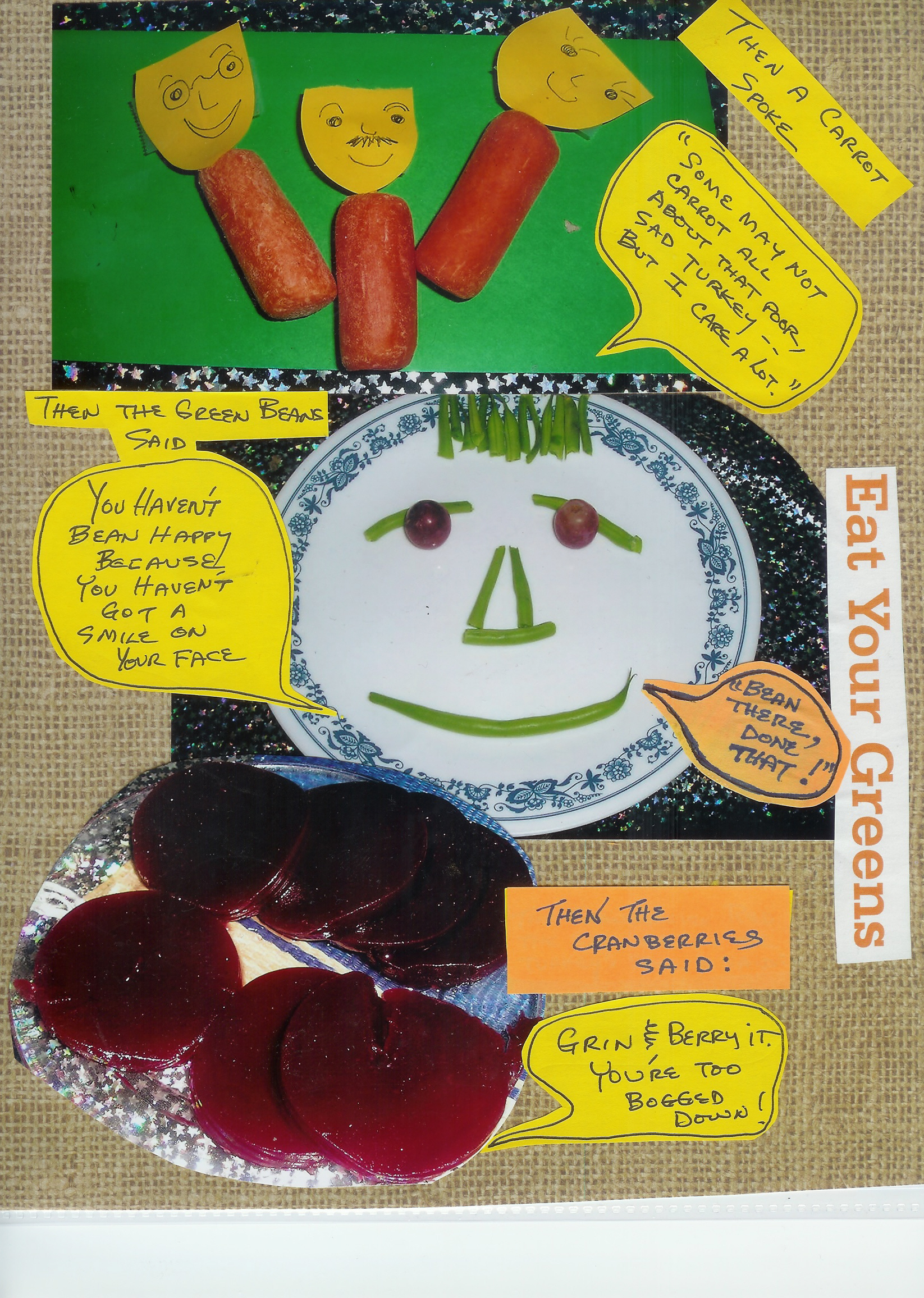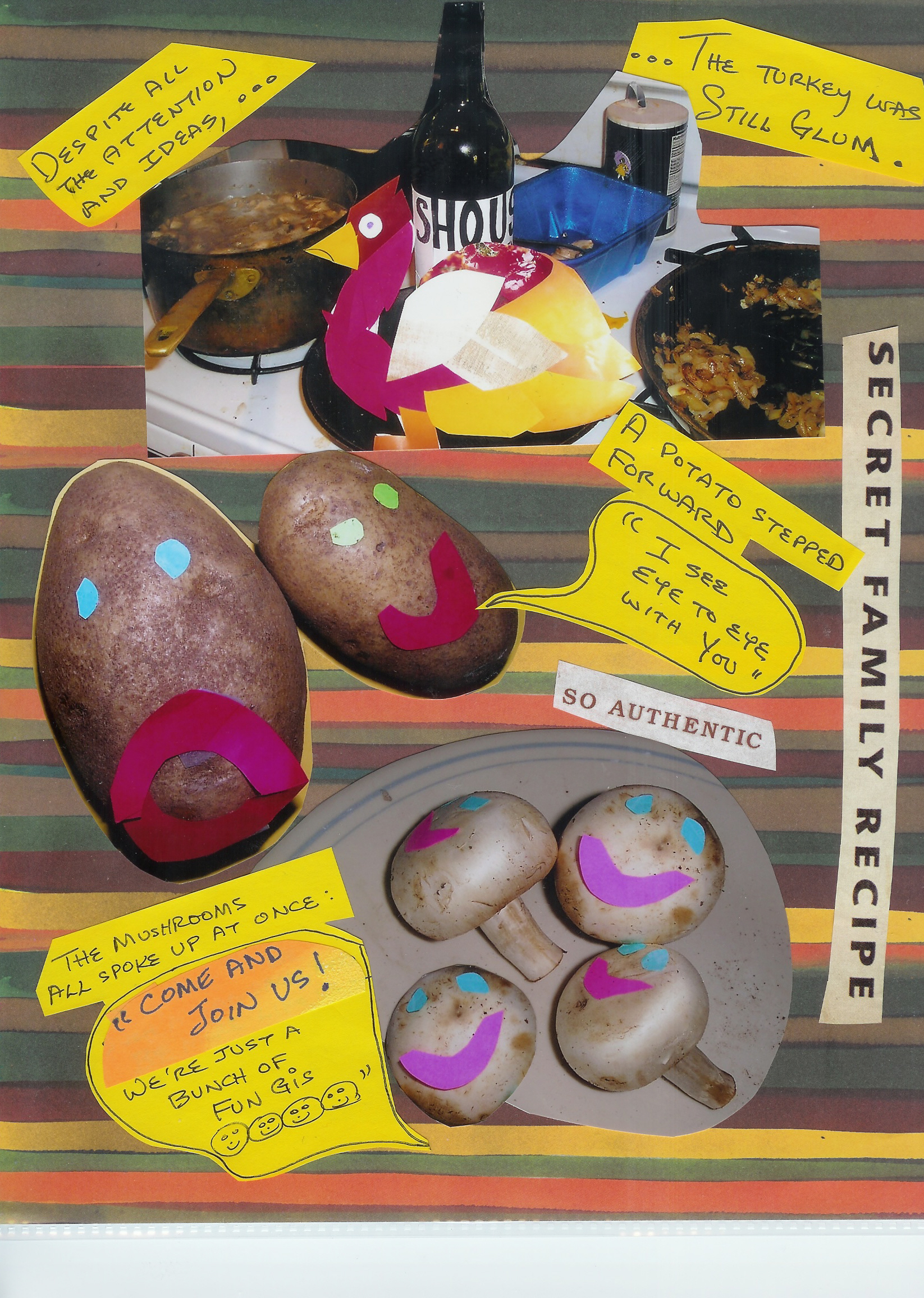Posts Tagged ‘collage’
Five Tips for a Terrific Collective Artistic Experience
Twenty years ago, Jytte Fogh Lokvig found herself in a quandary. She was doing a favor for a friend: visiting the friend’s mom weekly while the friend was out of the country for three months. The mom lived in a care facility and the first visit went wonderfully. But the second visit was shocking to Jytte.
“Her mom started screaming and cursing,” Jytte says. “I went to the nurses’ station to figure out what was wrong. The nurse told me she had Alzheimer’s.”
Jytte, who had experience in art and working with at-risk youth, knew nothing about dementia. But she started to learn. Using principles she’d employed with youth, she began offering additional activities at the facility.
“I didn’t view people with dementia as sick,” she says. “Everything I planned was directed at the well part of the person.”
She looked for activities that were collaborative rather than competitive, so everyone could bloom with a feeling of accomplishment.
“I started with a group collage,” she says. “That way, we were all working together.”
Through the process of creating collectively, people relaxed and became comfortable with the materials. This experience was so fulfilling and moving that Jytte began working with families, guiding them in doing projects together.
Jytte suggests collages because they are easy and there is no right or wrong with collage.
“Collect old magazines, buy a few glue sticks, and break down big boxes to use for cardboard,” she suggests. “Engagement and conversation are the important things; if it never gets beyond discussing a picture of daisies that reminds her of her growing up garden, that’s fine.”
Jytte believes the keys to engagement include giving people enough time, letting them work at their own pace, and offering them consistent opportunities for self-expression.
When possible, invite others to join you for the collage experience. Introduce the project by asking the person with dementia for help, saying, “Hey Mom, I really want to do this project. Want to help me?”
If Mom is reluctant, start the project and mention; “I sure could use your help if you don’t have anything else to do.”
Tear pictures out of colorful magazines.
Let Mom direct the artistic action.
Use the pictures to trigger conversation.
Enjoy the process and don’t worry about a finished product.
***
Jytte Fogh Lokvig, PhD, is the author of The Alzheimer’s Creativity Project and Alzheimer’s A to Z, Secrets to Successful Caregiving. She is also a founder of the Alzheimer’s Café.
Deborah Shouse is the author of Love in the Land of Dementia: Finding Hope in the Caregiver’s Journey.
Transforming Attitudes Through Art
“Art enables us to find ourselves and lose ourselves at the same time.”
~ Thomas Merton
The art therapist shows up at our house, bumping along a rolling suitcase filled with supplies. Her hospice client, my life partner Ron’s 97 year-old mother Mollie, is slumped on our sofa, her head thrown back, her eyes closed. As forgetfulness nibbles away at her mind, her indifference increases.
“Hi Mollie, I’m Denise the art therapist.” Denise introduces herself again, even though they have met several times.
“Whatever,” Mollie says.
Denise unzips her suitcase and begins taking out art supplies: pink, red, yellow and green bolts of crunchy tissue paper, a plastic box of small colorful felt squares, hearts, circles, stars and triangles, two bottle of Modge Podge glue, and several paint brushes.
Denise settles beside Mollie, with a black piece of paper and some red and pink tissue.
“What color do you like best?” she asks.
Mollie shrugs but points to the pink. Denise paints a strip of glue onto her paper and sticks a crumpled bud of rose paper.
“Mollie, what shape appeals to you?” Denise asked, offering a purple felt square and a red triangle.
Mollie points to the square.
“I don’t know what to do,” Mollie says, a frequent refrain. Her encroaching confusion has knocked the center out of her normal confidence and rendered her nervous.
“Just sit here with me and help me make this picture,” Denise says.
Denise offers Mollie a choice between lilac and purple tissue, then sea green and dark green options.
“You’re an artist,” Mollie says, looking at the tissue flowers that have miraculously bloomed on the page. A garden is beginning. “You’re really an artist,” Mollie repeats and Denise smiles.
“Thank you Mollie. Can you take this brush and spread the glue?”
The brush shakes in Mollie’s hand but she manages to even out the glue, preparing the page for a tangerine and lemon colored blossom.
“This is art,” Mollie says.
“You like art, don’t you?” Denise says. “You have quite an art collection.”
Mollie nods. As she spreads the next glump of glue, Denise asks her about the antique shop she ran for many years and about her travels to get art. Mollie answers but she seems more focused on the page in front of her, the new art that Denise is bringing into her life.
Deborah is the author of Love in the Land of Dementia: Finding Hope in the Caregiver’s Journey.
The HERO Project: Four Steps to Creating Scraps of Stories That Connect
One summer, my parents and my 10-year-old nephew Jake were visiting me and I wanted an activity we could all do together. Normally, Jake and Mom had a grand time together; but my mother, in her early stages of Alzheimer’s, wasn’t the grandmother Jake was used to. Jake knew his grandmother had something wrong with her but he didn’t know what to do about it. So I created a family project, a simple story scrapbook, complete with photos and a storyline, starring Jake and Nana and my father.
Since Jake was interested in strength and power, I created a tale where the strongest kid learns about something even more powerful than physical prowess – love. 
Designing a Project We Could All Participate In
This was a healing project for my family.
Jake and I worked on the storyline, then shared it with my parents. I took photos as they acted out the script. My mother was going through a stage of being very resistant and she had a good time acting out her frustration. My depressed father actually smiled and laughed during the photo shoot.
When I had developed the photos, we sat around the table and put the scrapbook together. Mom and Dad enjoyed leafing through magazines for extra sayings and words to spice up the pages. Most of all they enjoyed sitting around, focused on something other than the confusion of Mom’s Alzheimer’s.
We all loved the finished product. Our story scrapbook had a meaningful message and we shared the project with our friends and relatives. It was a way to let people know, “We’re still here and we’re still having fun, despite Mom’s diagnosis of dementia.” Reading this story inspired people to reach out to my parents and stay connected.
Chasing Away the Holiday Blues and Adding Creative Jazz to Our T-Day
We did other story scraps –some with our family as a group, others starring individuals. Each time we loved the process and the results. We called this work, The HERO Project, because we were inviting people to have fun and be seen as the heroes they really were.
 One Thanksgiving, when I was grieving because Mom could no longer help with the holiday meal, I created a HERO Project called, “The Little Kitchen that Could.” The story starred all of us and gave us a creative focus during that difficult holiday period. My parents smiled as we sat around the dining room table, preparing for our photo shoot by taping paper faces on my pots and pans and giving the unpeeled potatoes big grins. They smiled again as they stood in the kitchen and acted out “refusing to help with the dishes.” Later, they enjoyed sitting with us as we put together our story scrapbook.
One Thanksgiving, when I was grieving because Mom could no longer help with the holiday meal, I created a HERO Project called, “The Little Kitchen that Could.” The story starred all of us and gave us a creative focus during that difficult holiday period. My parents smiled as we sat around the dining room table, preparing for our photo shoot by taping paper faces on my pots and pans and giving the unpeeled potatoes big grins. They smiled again as they stood in the kitchen and acted out “refusing to help with the dishes.” Later, they enjoyed sitting with us as we put together our story scrapbook. 
Four Stunning Steps to the HERO Project
These projects are easy and fun and can involve as many people as possible.
- Write a simple story that has humor and meaning.
- Stage a photo shoot, taking pictures that illustrate your story. Fill in with old photos or magazine pictures.
- Create a collaging session, where everyone gathers to put together the script and pictures in a low-key scrapbook.
- Celebrate by sharing your book with everyone!
For more examples of HERO Projects, visit The HERO Project link at www.TheCreativityConnection.com/

